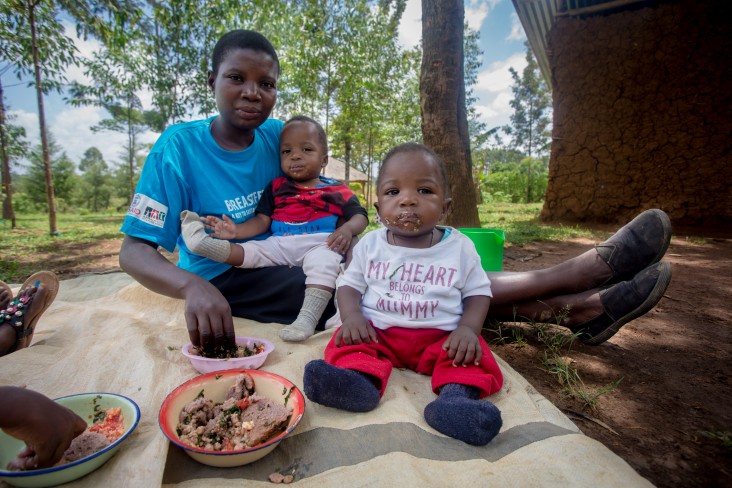Speeches Shim

USAID Nutrition Investments, FY16: $4,000,000
26% of children in Kenya are stunted, a sign of chronic malnutrition1
In 2016, nearly 4.5 million children in Kenya were reached with nutrition programs supported by USAID and other U.S government agencies
92% of malnourished children 6 months to 2 years old reached by nutrition hearth groups reached their recommended weight
Less than a year after giving birth to her twin sons, Melanie Atieno’s health worker alerted her that both her sons were malnourished. Melanie did not know how to get her sons the foods they needed to thrive; “I felt frustrated,” she explained. Melanie’s sons were not alone. In Kenya, over one-quarter of all children under five are stunted, a sign of chronic malnutrition. Over the past decade, Kenya has seen major improvements in children’s nutritional status, but certain rural regions still face stunting rates as high as 39%.2 Nurses and community health workers in rural regions of Kenya had been working for years to regularly identify and treat malnourished children, yet progress was slower than expected. This all changed when USAID started to teach nurses a more effective method to treat these malnourished children.
“Previously, we used to give the moderately malnourished children food by prescription and sometimes we’d give them [maize] flour to make porridge,” explains Christine Ochieng, a community nurse. “But, when they get home, make and serve the food, all the other children will share.” Sharing the food meant the children in need were not getting all the nutrients required for rehabilitation. In addition, nurses struggled with parents’ concerns of stigma around the prescribed food, as this food is also used to treat malnourished people living with HIV. Parents worried that people would think someone in their family had HIV, so they would throw away the food rather than feed it to their child. Left feeling discouraged and unable to overcome these barriers, health workers struggled to help malnourished children in their community fully recover.
Frustrated with the lack of success in treating malnutrition in her county, Christine attended a USAID-supported training that offered an alternative method to treating malnutrition among children 6 months to 2 years old: the Positive Deviance (PD) Hearth approach. Using this approach, nurses and other community health workers from Kenya’s Busia and Siaya counties were trained on how to help mothers learn to prepare, cook, and feed their malnourished children nutritionally-balanced meals with locally available food items. These education and rehabilitation sessions were designed to take place in local women’s homes, or “hearths”.
Following the training, health workers weighed and measured each child in their community to identify those who were moderately malnourished. Malnourished children and their mothers were then enrolled in community health worker-led hearth groups, comprised of 10 mothers and their children who cooked and ate together every afternoon for 12 days. Each family brought the foods that were available to them such as eggs, pumpkin leaves, sukuma wiki (kale) and milk, and these foods were used to create a meal for everyone to share.
As Nyando, another Kenyan nurse from the same community, describes, “what we were trying to show them is that the same nutrients that are found in the food that they depend on from our facilities, they can provide for themselves locally.”
In the hearth groups, health workers taught mothers how to plan meals for their children and detailed the components of proper feeding, including washing hands before cooking and thoroughly cleaning fruits and vegetables. They encouraged mothers to share what they learned in the groups with others in their community
Small Groups, Big Results
After just two weeks of the program, Melanie Atieno went from feeling frustrated to empowered in her ability to improve her children’s health and nutrition. Through participation in the PD Hearth program, she was able to help both her sons rise from malnourished to healthy weight status. Melanie’s sons were just two of many children whose weight drastically improved as a result of these efforts. Of the 116 children who participated, about 92 percent reached their recommended weights. In this initial phase, efforts focused on specific communities in the Busia and Siaya counties. Due to the widespread success, USAID has expanded this approach to four other counties in Kenya facing high rates of malnutrition.
By empowering families to improve children’s nutritional status through the use of local foods, USAID is helping to give communities the tools they need to improve their own health. Enhancing the nutritional status of young children is key to ensuring they have the ability to grow and develop into healthy, productive citizens.
Meet more of the women and children that benefit from USAID's efforts.
« Back to the Acting on the Call home page
1 Kenya 2014 Demographic and Health Survey. The DHS Program.
2 Ibid.

Comment
Make a general inquiry or suggest an improvement.